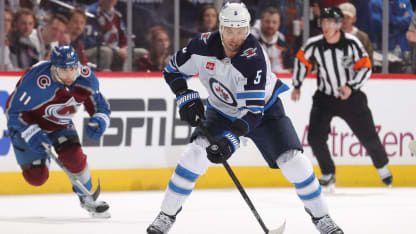DENVER – Brenden Dillon escaped disaster on Friday night.
When the Winnipeg Jets defencemen left the ice with a cut on his land from a skate blade – the result of falling to the ice during a big scrum at the final buzzer – there was concern throughout the dressing room for the veteran’s well-being.
Dillon is officially listed as day-to-day, but things could have been much worse.
“There’s no damage and that’s the most important thing,” said Jets head coach Rick Bowness. “It didn’t look good so it’s a big sigh of relief.”
The 33-year-old has three assists in the series – which the Colorado Avalanche now lead 2-1 after winning Game 3 – but Dillon has also been a physical presence and is a key member of the Jets penalty kill (his 2:14 average shorthanded ice time per game this season is second only to Dylan DeMelo).
“He’s often the heartbeat of the team,” said Neal Pionk, who has spent the majority of the season paired with Dillon. “He’s throwing his body around, stirring the pot out there and blocking a lot of shots and doing the little things that might not end up on the scoresheet, so he’s a big part of the team.”
Even though the Jets had a quick practice at Ball Arena on Saturday – which Dillon didn’t partake in – there is no indication of what Winnipeg’s defensive pairs will look like come puck drop on Sunday afternoon.
The formal part of the skate lasted about 20 minutes before the players moved into individual and position specific work. Bowness said line-up conversations will happen throughout Saturday afternoon, but replacing what Dillon brings will be a challenge.
“He’s one of our toughest competitors, tremendous teammate and he gives you 100 percent every shift out there,” said Bowness. “He’s tough as nails, he battles everybody, he blocks shots. I mean, he does everything you want your veteran D to do and he’s a great leader on the ice and in the room. He brings a lot to the table for us.”
Dillon’s injury brings back memories of last spring, when Jets forward Morgan Barron was cut just above the eye with a skate blade against Vegas. Earlier this season, Nino Niederreiter’s cut resistant socks prevented him from missing significant time when he was cut on the leg (below the protection of the skate boot).
In all those situations, the Jets medical team stepped up, and this case was no different.
“Our doctors did a fantastic job,” said Bowness. “They got right at it and did a great job stitching him up.”
STAYING CONFIDENT
After winning Game 1, the Jets have had leads in both Game 2 and Game 3 before the Avalanche pulled away. In Game 2, it was three goals in 5:37 that turned a 2-1 Jets lead into aa 4-2 deficit. In Game 3, it was a stretch of three goals in six minutes – with two coming on the power play – that once again erased a Winnipeg lead.
“We have these five-, six-, seven-minute lapses that are really slipping away from us,” said Pionk. “We’ve got to make some plays when they’re there, and if they’re not, flip it out and restart.”
Despite that, the Jets remain confident in their game. There are many examples from throughout the regular season – and even within this series – of Winnipeg responding in tough situations.
“I think we just have a lot of trust in this group and the depth we have, guys stepping up in different moments,” said captain Adam Lowry. “Every game is going to be different in this series. We’re just going to look to bounce back. Kind of what Colorado did. We were able to get the upper hand in Game 1, they played really well in Game 2 and got the split. That’s our job now, to take care of business tomorrow.”
Lowry acknowledged that the Jets penalty kill needs to improve (it’s currently killed seven of Colorado’s 11 power plays), but keeping the game at five-on-five remains a priority.
“If you look at the majority of five-on-five play last night, I thought we did a lot of really good things,” said Lowry. “I think staying on top of their D, managing the puck high in the zone and not allowing those easy rush chances against is going to be critical. And just getting back to our style of play.”
Bowness wants his team to have a bit more of a shoot-first mentality, but at the same time, not just shoot at Alexandar Georgiev just to put a puck on net. The timing of having bodies at the net – like they were in layers on both of Josh Morrissey’s goals in this series – is also important.
Colorado blocked 15 shots in Game 3, many of those coming from defenceman stepping in front of pucks coming from the point and preventing them from getting to Georgiev.
“We’re going to have to try and spread it out a little bit more so there are fewer bodies at the net, so the D actually have a chance to get the puck on the net,” said Bowness. “As soon as we see that opening, they have to get ready to shoot the puck. They can’t get ready for a second option or they can’t wait.”
After that, it’s up to the Jets to get the first touch on those loose pucks.
“When we're playing well and we have guys in motion going to the net, you tend to get those loose pucks recovered,” said Lowry. “You can go low to high. You can create some more sustained pressure and it really causes confusion and causes them to have to make decisions on their sort outs because they're collapsing to the net and you're spreading the zone.”
The problems that have caused the Jets issues in the last couple games are fixable. And despite trailing 2-1 in the series, the group remains confident they can earn a split in this visit to Denver.
“I think we've got a lot of belief in this group with the depth that we have. Helle is a world-class goaltender and I think our back end is really solid,” said Lowry. “So it was a disappointing third period (in Game 3) for sure. But we looked at some clips today and now we're getting ready for Game 4."



















